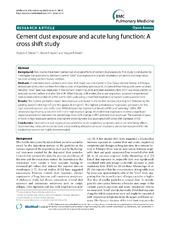| dc.contributor.author | Zeleke, Zeyede K. | en_US |
| dc.contributor.author | Moen, Bente E. | en_US |
| dc.contributor.author | Bråtveit, Magne | en_US |
| dc.date.accessioned | 2011-01-04T12:52:01Z | |
| dc.date.available | 2011-01-04T12:52:01Z | |
| dc.date.issued | 2010-04-14 | eng |
| dc.Published | BMC Pulmonary Medicine 10(19) | en |
| dc.identifier.issn | 1471-2466 | |
| dc.identifier.uri | https://hdl.handle.net/1956/4367 | |
| dc.description.abstract | Background: Few studies have been carried out on acute effects of cement dust exposure. This study is conducted to investigate the associations between current "total" dust exposure and acute respiratory symptoms and respiratory function among cement factory workers. Methods: A combined cross-sectional and cross-shift study was conducted in Dire Dawa cement factory in Ethiopia. 40 exposed production workers from the crusher and packing sections and 20 controls from the guards were included. Personal "total" dust was measured in the workers' breathing zone and peak expiratory flow (PEF) was measured for all selected workers before and after the shift. When the day shift ended, the acute respiratory symptoms experienced were scored and recorded on a five-point Likert scale using a modified respiratory symptom score questionnaire. Results: The highest geometric mean dust exposure was found in the crusher section (38.6 mg/m3) followed by the packing section (18.5 mg/m3) and the guards (0.4 mg/m3). The highest prevalence of respiratory symptoms for the high exposed workers was stuffy nose (85%) followed by shortness of breath (47%) and "sneezing" (45%). PEF decreased significantly across the shift in the high exposed group. Multiple linear regression showed a significant negative association between the percentage cross-shift change in PEF and total dust exposure. The number of years of work in high-exposure sections and current smoking were also associated with cross-shift decrease in PEF. Conclusions: Total cement dust exposure was related to acute respiratory symptoms and acute ventilatory effects. Implementing measures to control dust and providing adequate personal respiratory protective equipment for the production workers are highly recommended. | en_US |
| dc.language.iso | eng | eng |
| dc.publisher | BioMed Central | eng |
| dc.relation.ispartof | <a href="http://hdl.handle.net/1956/5195" target="blank">Respiratory Health among Cement Workers in Ethiopia</a> | eng |
| dc.rights | Attribution CC BY | eng |
| dc.rights.uri | http://creativecommons.org/licenses/by/2.0 | eng |
| dc.title | Cement dust exposure and acute lung function: A cross shift study | en_US |
| dc.type | Peer reviewed | |
| dc.type | Journal article | |
| dc.description.version | publishedVersion | en_US |
| dc.rights.holder | Copyright 2010 Zeleke et al; licensee BioMed Central Ltd. This is an Open Access article distributed under the terms of the Creative Commons Attribution License (http://creativecommons.org/licenses/by/2.0), which permits unrestricted use, distribution, and reproduction in any medium, provided the original work is properly cited. | |
| dc.rights.holder | Zeleke et al | |
| dc.identifier.doi | https://doi.org/10.1186/1471-2466-10-19 | |
| dc.identifier.cristin | 511828 | |
| dc.subject.nsi | VDP::Medisinske Fag: 700::Helsefag: 800::Yrkesmedisin: 809 | nob |
| dc.subject.nsi | VDP::Medisinske Fag: 700::Klinisk medisinske fag: 750::Lungesykdommer: 777 | nob |

